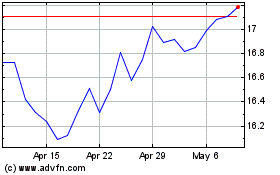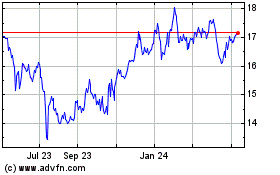Pentagon Readies for Battle in a 5G Future -- Journal Report
November 10 2020 - 6:19PM
Dow Jones News
By Asa Fitch
The U.S. military is preparing to fight on a new battlefield:
the 5G networks going up around the world.
The Pentagon is testing how lightning-fast 5G networks could
transform warfare, from training and logistics to mission planning
and communications to new battlefield tactics like the deployment
of drone swarms. It is throwing a lot of money at harnessing the
new technology -- partly, analysts say, with an eye on China, which
has made 5G a military priority.
In October, the Department of Defense said it would spend $600
million experimenting with 5G at bases across the country, building
on an earlier round of tests. Telecommunications and defense
companies are partners in the experiments, including mobile carrier
AT&T Inc. and defense contractor General Dynamics Corp.
Eye on China
The Defense Department began trying to understand what 5G means
for its operations several years ago, and last year started
conducting tests with 5G at about a dozen sites. The latest
experiments are broader in scope and have more funding behind
them.
"These aren't just little demonstrations in a small area showing
a science experiment," Joseph Evans, the department's principal
director for 5G, said last month when the $600 million in funding
for 5G projects was announced. "These are at-scale deployments of
5G technology and evaluation of [Defense Department] and industry
dual-use type of applications" -- cases where a 5G product sold for
civilian purposes might also have military uses.
China is taking similar steps, analysts say. The country
generally hasn't been public about its experimentation with
military use of 5G, but analysts say it has worked to combine
private-sector know-how with its defense-industrial complex,
illustrating how promising its leaders believe the technology could
be in warfare. Virtually from the outset of the communication
standard's development, China has sought to be the 5G leader
globally and has explored military applications.
The U.S. has become increasingly concerned about the deployment
of Chinese-made 5G equipment in telecommunications networks abroad,
which Washington says comes with security concerns that Chinese
companies deny. "Worldwide expansion of 5G networks by [Chinese]
companies will challenge the security and resiliency of other
countries' networks," the Pentagon said in a recent report. The
concern is that the equipment could be used for spying on network
users or to conduct cyberattacks, a possibility that has been
denied by the Chinese government as well as the country's makers of
5G equipment.
Chinese equipment has been effectively banned from U.S. telecom
networks, but the U.S. military often operates in countries where
local telecommunications networks use Chinese gear. While the U.S.
can set up secure 5G networks on the bases it operates, when troops
go into local towns their communications may be compromised, the
military fears. So the Pentagon is looking for ways to keep
American soldiers' communications secure when they deploy overseas,
even if those 5G networks use Chinese equipment.
Offense and defense
Among other purposes, the Pentagon could use the new technology
to ensure more robust and secure battlefield communications. China
and Russia have invested heavily in the ability to jam military
communications, and 5G could allow the U.S. to mitigate their
effectiveness, says Dan Gonzalez, a senior scientist at Rand Corp.,
a military-focused think tank. The way communications signals are
handled by 5G networks makes them harder to disrupt, he says.
"Any technology that can provide some protection against
electronic-warfare threats would be very useful," Mr. Gonzalez
says. How to employ such systems is still being developed, though,
he says.
The Pentagon has been experimenting on communications resiliency
at Nellis Air Force Base outside Las Vegas. There, the military is
rethinking the traditional Air Force command center -- the central
node in an air war where missions are planned and targets assigned.
Instead of locating that staff in one place that can be targeted by
an adversary, 5G could allow teams to be distributed and
mobile.
Another potential application of 5G technology is based on its
ability to handle massive amounts of data, allowing users to
connect millions of devices through the so-called Internet of
Things. For the Pentagon, that potentially means being able to
track where every bomb and bullet is stored, making it easier to
get the right supplies to the right places on time -- a crucial
factor in wartime.
The military is also betting 5G could unlock more futuristic
applications. Developers are working on augmented reality and
virtual reality for mission planning, training and combat. Those
efforts complement other advances in training the military has
worked on over the past several years, including VR-assisted
simulators of M240 and 50-caliber machine guns.
The Pentagon also sees 5G enabling drones to form into a swarm
more resilient to enemy attacks than a single unmanned
aircraft.
At the same time, the Defense Advanced Research Projects Agency,
the Pentagon's emerging-technology development unit, is trying to
ensure enemies can't exploit security vulnerabilities in 5G
networks, says Jonathan Smith, the agency's program manager at the
Information Innovation Office.
With 5G, for example, frequencies can be broken up into multiple
communication channels called slices that an enemy could try to
hack into. "Data from [Internet of Things] devices on a ship or a
plane or a warehouse or something like that could tell an adversary
an awful lot about what's going on logistically in our world," Mr.
Smith says. "That's why we put a lot of thinking into how to secure
a slice."
Mr. Fitch is a Wall Street Journal reporter based in San
Francisco. He can be reached at asa.fitch@wsj.com@wsj.com.
(END) Dow Jones Newswires
November 10, 2020 18:04 ET (23:04 GMT)
Copyright (c) 2020 Dow Jones & Company, Inc.
AT&T (NYSE:T)
Historical Stock Chart
From Mar 2024 to Apr 2024

AT&T (NYSE:T)
Historical Stock Chart
From Apr 2023 to Apr 2024
